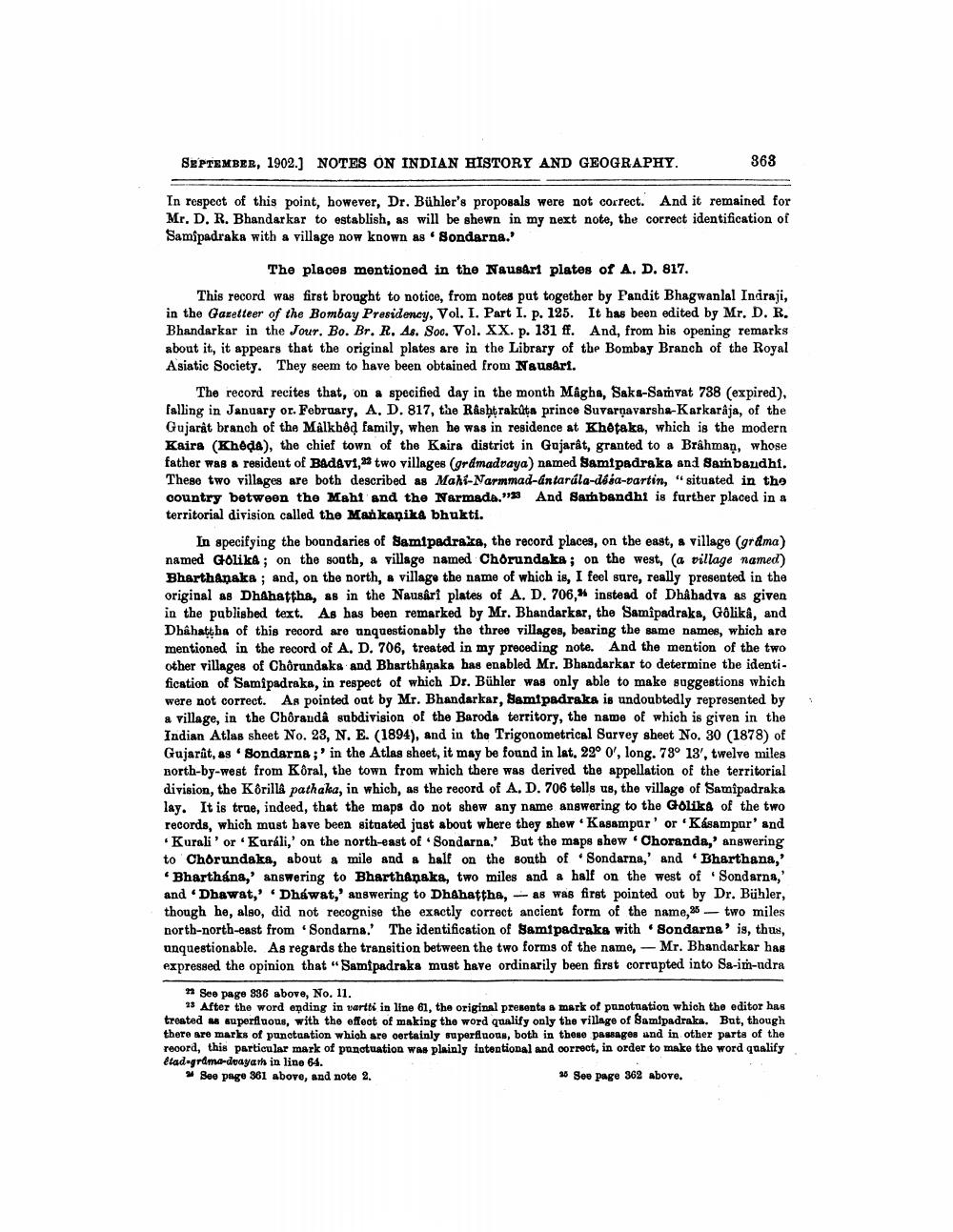________________
SEPTEMBER, 1902.) NOTES ON INDIAN HISTORY AND GEOGRAPHY.
363
In respect of this point, however, Dr. Bühler's proposals were not correct. And it remained for Mr. D. R. Bhandarkar to establish, as will be shewn in my next note, the correct identification of Samspadraka with a village now known as Sondarna.'
The places mentioned in the Nausart plates of A. D. 817. This record was first brought to notice, from notes put together by Pandit Bhagwanlal Indraji, in the Gazetteer of the Bombay Presidency, Vol. I. Part I. p. 125. It has been edited by Mr. D. R. Bhandarkar in the Jour, Bo. Br. R. As. Soc. Vol. XX. p. 131 ff. And, from bis opening remarks about it, it appears that the original plates are in the Library of the Bombay Branch of the Royal Asiatic Society. They seem to have been obtained from Nausari.
The record recites that, on a specified day in the month Magha, Saka-Samvat 738 (expired). falling in January or. February, A, D. 817, the Rashtrakūta prince Suvarņavarsha-Karkaraja, of the Gujarat branch of the Malkhôd family, when he was in residence at Khetaka, which is the modern Kaira (Kheda), the chief town of the Kaira district in Gujarat, granted to a Brâhman, whose father was a resident of Badevi,as two villages (grdmadvaya) named Sami padraka and Sambaudhi. These two villages are both described as Mani-Narmmad-antarála-désa-vartin, "situated in the country between the Maht and the Narmada." And Sambandhi is further placed in a territorial division called the Mańkanika bhukti.
In specifying the boundaries of Samtpadraka, the record places, on the east, a village (grama) named Golika; on the south, a village named Chorundaka; on the west, (a village named) Bharthanaka ; and, on the north, a village the name of which is, I feel sure, really presented in the original as DhAhattha, as in the Nausâri plates of A. D. 706, instead of Dhabadva as given in the published text. As has been remarked by Mr. Bhandarkar, the Samipadraka, Gôlika, and Dhåhattha of this record are unquestionably the three villages, bearing the same names, which are mentioned in the record of A. D. 706, treated in my preceding note. And the mention of the two other villages of Chôrundaka and Bharthanaka has enabled Mr. Bhandarkar to determine the identi. fication of Samipadraka, in respect of which Dr. Bühler was only able to make suggestions which were not correct. As pointed out by Mr. Bhandarkar, Samtpadraka is undoubtedly represented by a village, in the Chörandâ subdivision of the Baroda territory, the name of which is given in the Indian Atlas sheet No. 23, N. E. (1894), and in the Trigonometrical Survey sheet No. 30 (1878) of Gujarât, as Sondarna;' in the Atlas sheet, it may be found in lat. 22° 0', long. 73° 13', twelve miles north-by-west from Kôral, the town from which there was derived the appellation of the territorial division, the Korilla pathaka, in which, as the record of A. D. 706 tells us, the village of Samipadraka lay. It is true, indeed, that the maps do not shew any name angwering to the Golika of the two records, which must have been situated just about where they shew Kasampur' or 'Kásampar' and • Kurali' or 'Kuráli,' on the north-east of Sondarna.' But the maps shew 'Choranda,' angwering to Chorundaka, about a mile and a half on the south of Sondarna,' and Bharthana,'
Bharthána,' answering to Bharthanaka, two miles and a half on the west of Sondarna,' and Dhawat,' 'Dháwat,' answering to DhAhattha, -48 was first pointed out by Dr. Bühler, though he, also, did not recognise the exactly correct ancient form of the name, 25 — two miles north-north-east from Sondarna.' The identification of Samipadraka with Sondarna' is, thus, unquestionable. As regards the transition between the two forms of the name, - Mr. Bhandarkar has expressed the opinion that "Samipadraks must have ordinarily been first corrupted into Sa-im-ndra
* See page 836 above, No. 11.
33 After the word onding in vartti in line 61, the original presents a mark of punctuation which the editor has treated as superfluous, with the effect of making the word qualify only the village of Samipadraka. But, though there are marks of punctuation which are certainly superfluous, both in these passages and in other parts of the record, this particular mark of punctuation was plainly intentional and correct, in order to make the word qualify etad-grima-doayan in line 64. ► See page 361 above, and note 2.
25 See page 362 above.




